In this tutorial, you'll acquire valuable tips and best practices for information modelling in Power BI. You can picket the total video of this tutorial at the lesser of this blog.
This is one of the four pillars of Ability BI report development and is a proven method to develop reports with ease. Honing in on your data modelling skills will greatly improve your reports and outputs.
Approaches To Data Modelling In Power BI
Setting up a data model starts with organizing your tables. There are two ways you tin can fix them up:
ane. Star Schema Arroyo
One of the all-time ways is past using the Star Schema arroyo:
- Value (or Fact) table at the center of the star
- LookUp (or Dimension) tables at the stop points of the star

Here is an example:
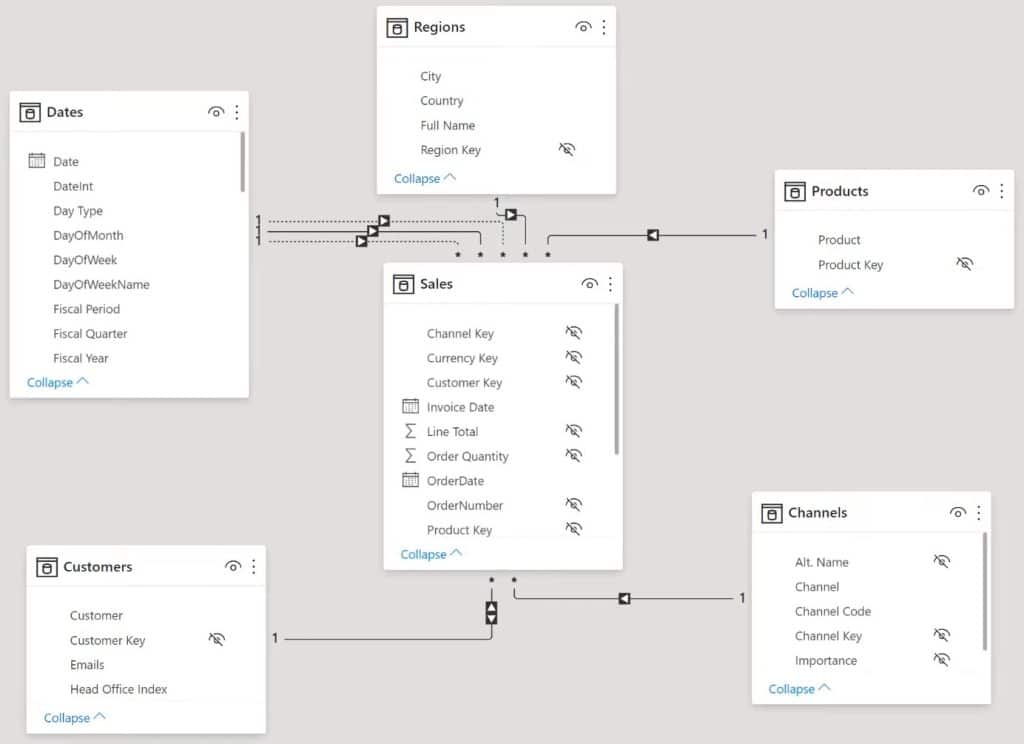
You tin can see that the Fact Table, Sales, is at the center while the Dimension Tables are positioned to wait like a star.
2. Waterfall Approach
The second approach and layout for data modelling in Ability BI is called the Waterfall technique. Y'all ready your LookUp Tables at the top and the Fact Tables at the lesser.
Hither are some of the benefits of this arroyo:
- Arranges tables in rows (LookUp tables in the first row, Fact tables in the second row).
- Easy to visualize the dimensions "falling" to the Fact table.
- Displays all relationships and makes it easier to see errors.
When using this layout, y'all need to think these details:
- Delete any relationships autogenerated by Ability BI.
- Manually create all relationships.
- Apply the "Manage Relationships" dialogue to maintain relationships.
With the Waterfall layout, you'll always see the LookUp Tables at the meridian, Fact Tables in the center, Mensurate Tables on the right, and Supporting Tables on the left.
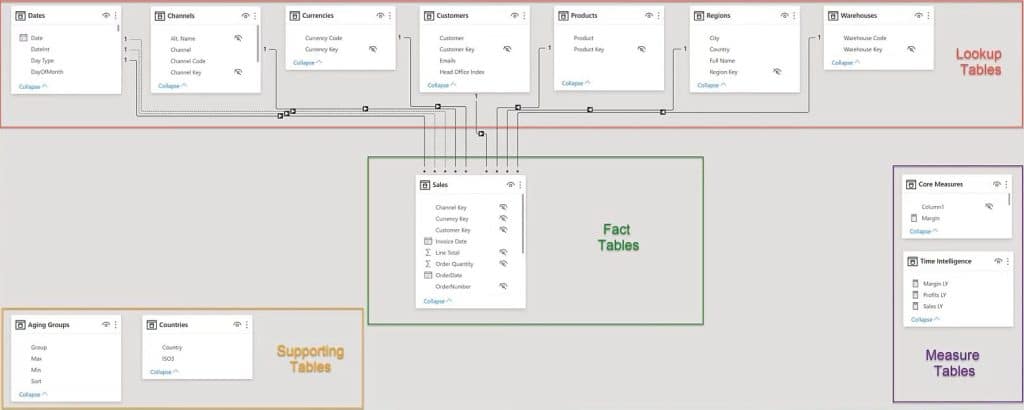
Data Modelling Relationships
To fully understand how relationships work when information technology comes to data modelling in Power BI, you need to know the following:
Using The Manage Relationships Dialogue
When using the Manage Relationships dialogue, y'all'll see the full list of relationships between each table and column.
This allows y'all to easily spot and right the keys used to join tables. You'll as well run across the state of each human relationship that you tin can actuate or inactivate.
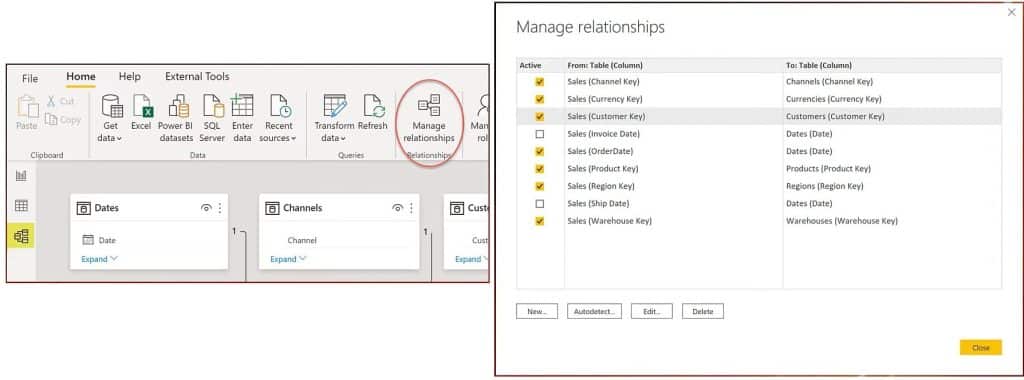
Selecting the Manage Relationships dialogue in the model view will let yous see all the relationships.
Take annotation that you lot can't have two active relationships between the same tables.
In this case, you lot demand to inactivate the Invoice State and actuate the relationship for Order Date earlier you lot tin shut it.
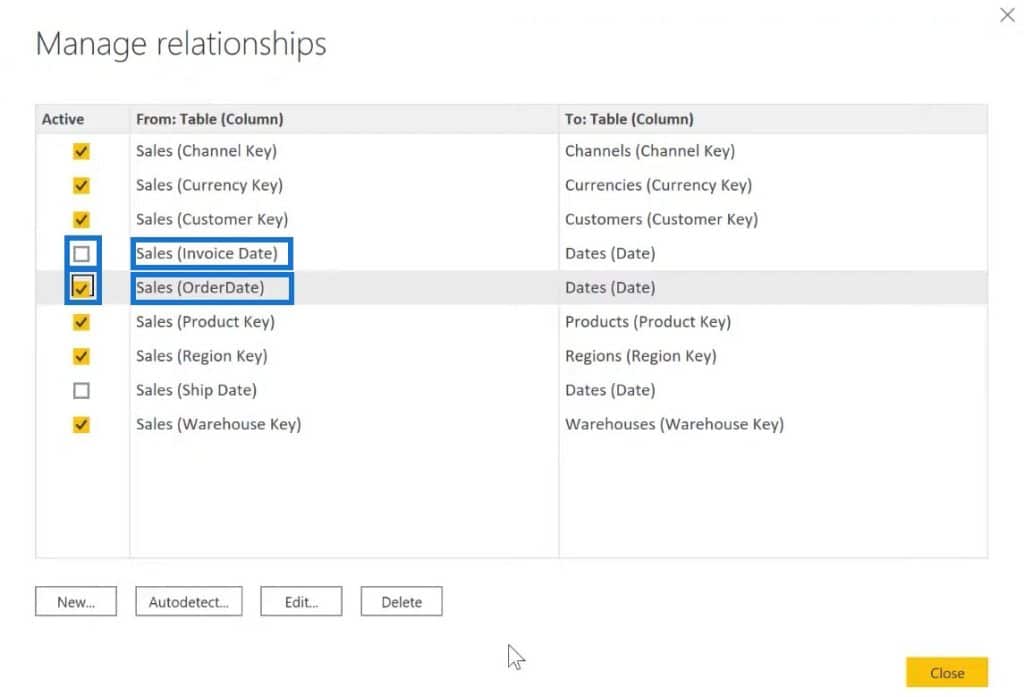
Setting Upwards The Cardinality For Data Modelling In Power BI
You can view the cardinality and management of each relationship using the Edit Human relationship dialogue. Ideally, the relationships should have a 1-to-many or many-to-one cardinality.
Power BI is excellent at setting the cardinality to default; information technology sets it according to your data.
If you get to the Edit Human relationship dialogue, yous'll run across the relationship between Sales and Channels.
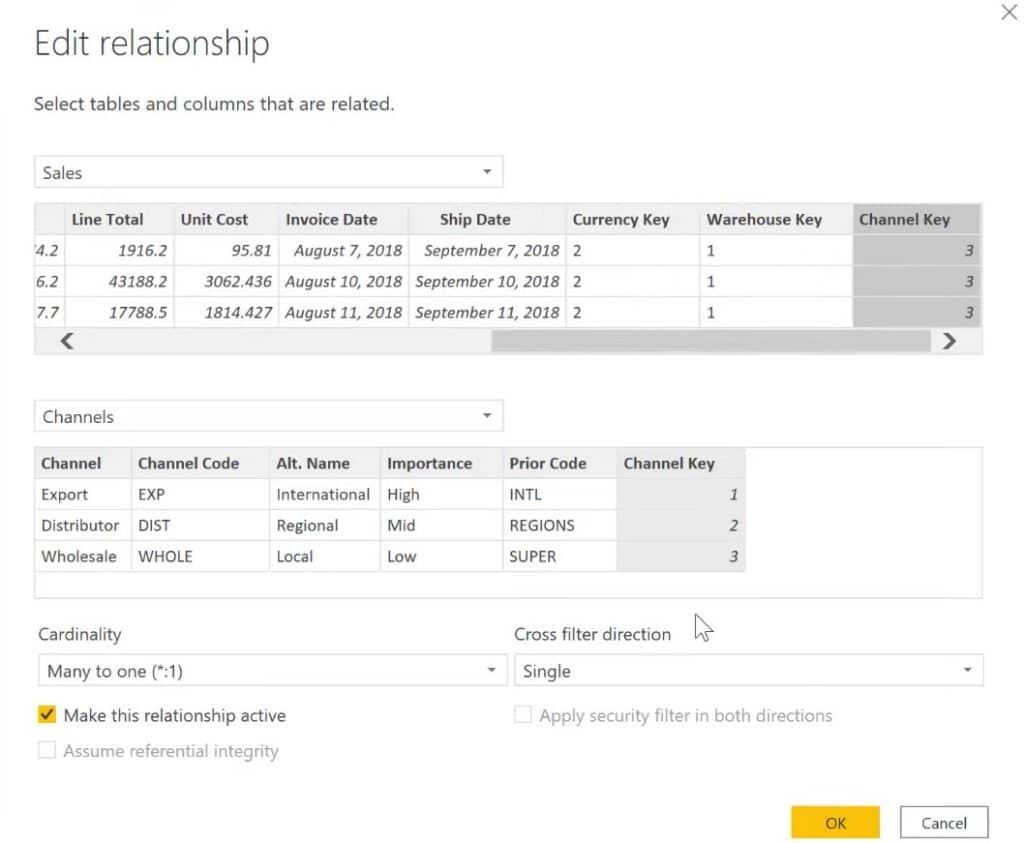
Power BI picks up a aqueduct key betwixt the 2 tables.
You lot can choose your cardinality and make certain it's in the right number. You also demand to make sure that you edit the Cross Filter Direction depending on your information model.
Power BI oft chooses Single for the Cross Filter Direction, merely in some cases, information technology will choose the Both selection.
If you see that Both is the default, confirm if the data in your data set is loaded and transformed as intended. Later, switch it back to Single or to your particular situation if possible.
Organizing Relationships In The Information Model
I-to-many relationships are denoted by a single arrowhead from one tabular array to many tables.

You have to avert bi-directional relationships which are denoted by double-directional arrowheads. Bi-directional relationships can lead to inconsistent results and often require a more complicated DAX code.

Using Active And Inactive Relationships
Side by side, yous need to understand the active and inactive relationships between tables.
You can just take one agile relationship betwixt ii related tables, simply you tin can have every bit many inactive relationships as you lot want between them. Y'all tin can also use an inactive relationship on-demand in DAX measures using USERELATIONSHIP.

Take note that yous demand to deactivate a relationship outset before you tin activate another human relationship.
Measure Tables For Data Modelling In Power BI
You tin can add mensurate tables from the Dwelling menu and then by clicking Enter Data.
For this case, the tabular array is named Core Measures.
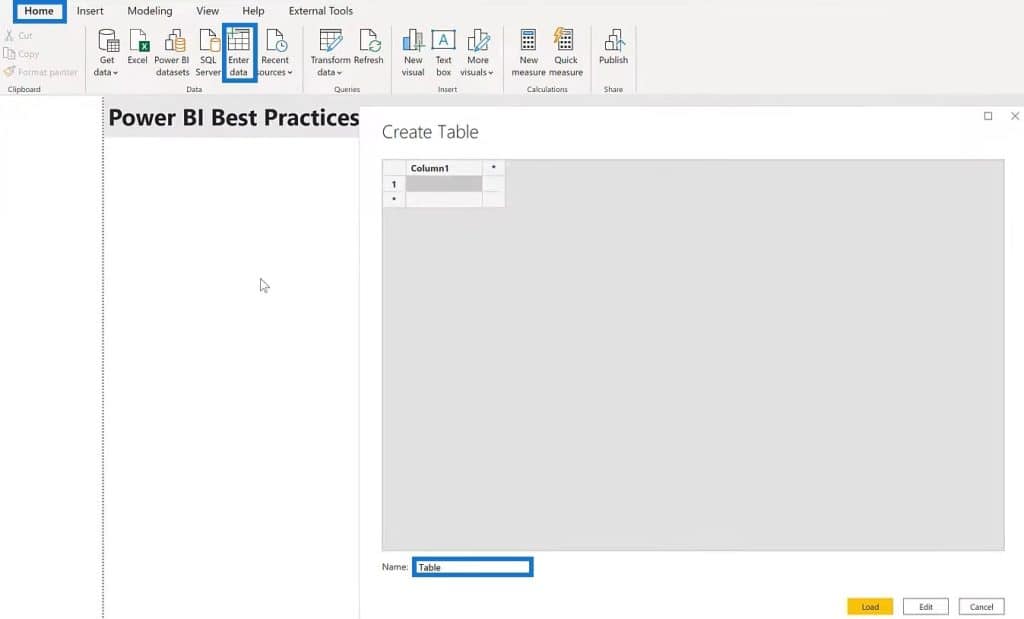
To add together a measure, correct-click the measure table and click New Measure.
When your model uses many measures, you can simplify your Fields pane past collapsing and expanding each measure out.

Columns In Data Modelling
Another thing yous should learn about Information Modelling is linking columns.
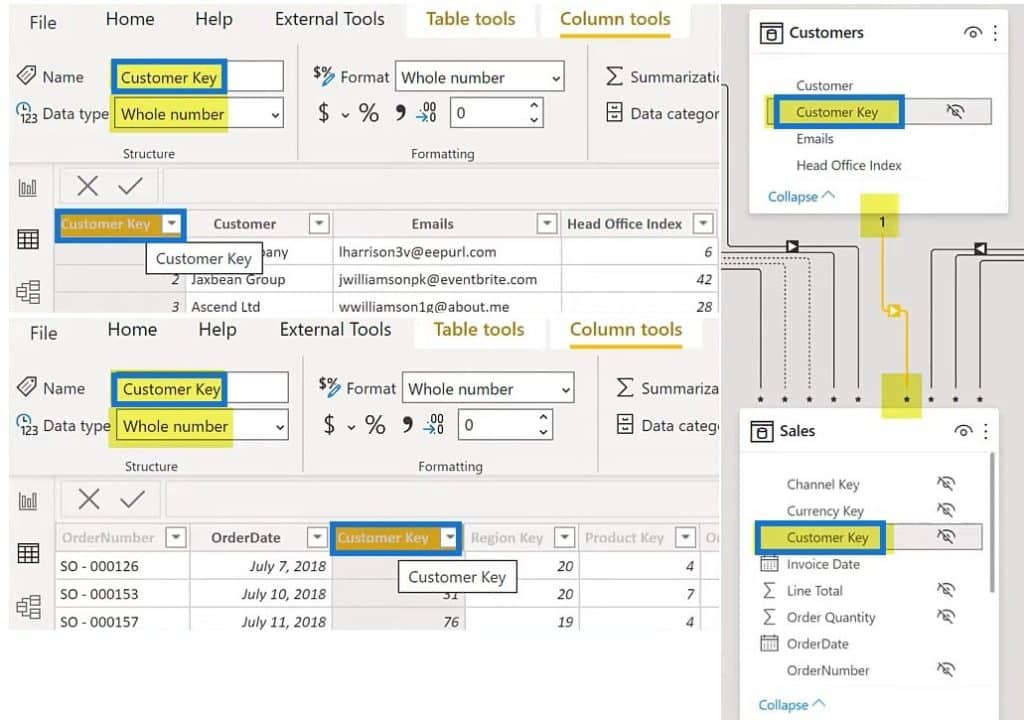
Another best practice is calculation the suffix "Key" for whatever column that you lot'll use for linking. When doing your data loading and data transformation piece of work, always ensure that the fields used for linking have the suffix and correct information blazon.
Link only columns that have the same proper name, such as Client Fundamental. Avoid columns that end with an ID or lawmaking as they mean unlike things in different tables.
Some other best exercise is to use integers considering information technology's always the fastest method.
Column Visibility For Data Modelling In Power BI
The last matter in this tutorial is about Column Visibility.
Column Visibility is where you:
- Hibernate all linking columns
- Hide all columns that end-users don't employ in visuals, specially in Fact tables
- Create base measures for all SUMdue south and COUNTsouth
- Reduce errors by preventing users from selecting "naked" columns
This is a skillful thing if you program to publish a study or data set for other people to use.
It helps users select the correct measures by hiding all the unnecessary columns in the model. This includes primal sorts and columns that can merely be used with a DAX code.
Hidden columns will appear grayed out:

If yous expand the Sales Table, you can meet the grayed out hidden columns. You tin can right click on the Field pane and choose your viewing options.
To hide a column, click the table of the column you want to hide. And then, right click on that cavalcade and choose Hide.

To view a subconscious cavalcade, right click on the field pane and click View Subconscious. You'll so see a grayed out column amidst the list.

Conclusion
This tutorial is very helpful to those who are having difficulty with data modeling in Power BI.
These tips will help you to create more organized layouts which make it easier to understand the relationships in your data gear up. Once you lot've fully grasped how to gear up data models, y'all can easily produce outstanding reports for cease users in your system.
Greg
***** Related Links *****
Building Data Dimensions In Power BI
Active And Inactive Data Relationships In Power BI
Building Your Data Model Relationships In Ability BI
***** Related Course Modules *****
Data Transformations & Modeling
Mastering Written report Development – Get-go to Stop
Best Practices & Feature Reviews
***** Related Support Forum Posts *****
Lose Measures And Reports When I Import A Data Model
Data Modelling?
Quick Book Online Data Modelling
For more data modelling back up queries to review run into hither….
DOWNLOAD HERE
Posted by: susanonsille.blogspot.com



Post a Comment